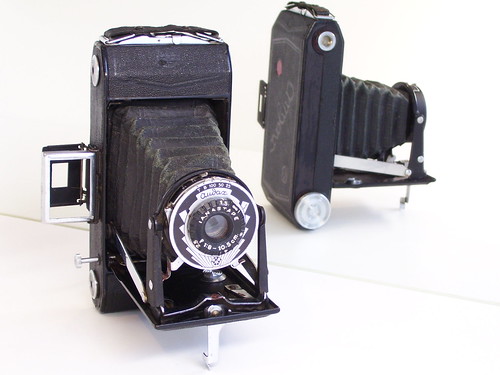Difference between revisions of "Audax"
(Deleted most of what I quoted from Cecchi.) |
Hanskerensky (talk | contribs) m (Redirected Link URL to archived version) |
||
| (4 intermediate revisions by 3 users not shown) | |||
| Line 7: | Line 7: | ||
|image_rights= with permission | |image_rights= with permission | ||
}} | }} | ||
| − | The '''Audax''' is a metal-bodied folding camera made in Italy in the | + | The '''Audax''' is a metal-bodied folding camera made in Italy in the 1940s by P&B of Turin<ref name=AD>[http://www.artdecocameras.com/cameras/pb/audax/ Audax] at [http://www.artdecocameras.com/ Art Deco Cameras]</ref>. It takes 2¼x3¼-inch exposures on [[120 film]]. A vintage advertisement suggests some were exported to Australia.<ref>[http://trove.nla.gov.au/newspaper/article/119218708 Advertisement in 24 November 1950 edition of The Southern Mail, Bowral (New South Wales), Page 9, for the Larelle Studio, with a list of cameras and their prices] at Trove</ref> Danilo Cecchi confirms that P&B were in Turin, and suggests they were active before and during the War; he refers to P&B's 'high-sounding' model names suitable for the dictatorship; Audax, Impero and Frecchia (roughly Daring, Empire, and Arrow).<ref>[https://www.nadir.it/ob-fot/CECCHI_IFI_2/italiane_02.htm L'Industria Fotografica Italiana. 2] Cecchi, Danilo (2001), hosted at [https://www.nadir.it/index.htm Nadir Magazine]</ref> No examples of the Impero or Frecchia have been seen. |
| − | |||
| − | |||
| + | The Audax has an Ianastare 10.5cm f/8 lens with front-element focusing down to 1.5 metre, and a shutter with three instantaneous speeds, 1/25 - 1/100, plus 'B' and 'T'. This has a release plunger on the camera body, and an attachment for a cable release on the shutter. There are ⅜-inch tripod bushes on the camera body (for horizontal pictures) and on the front (for vertical). There is also a folding 'foot' on the front door, which unusually folds ''sideways''. There is a folding frame finder on the body. In almost all respects, the Audax is identical to the Tennar, attributed to [[Fototecnica]], but sometimes seen with the P&B logo on the shutter face. The relationship, if any, between P&B and Fototecnica is not known. Notes on Fototecnica at ''Storia della Fotografia'' state that P&B was a manufacturer serving the distributor [[Roto]].<ref>[https://web.archive.org/web/20120411234209/http://www.storiadellafotografia.it/2012/04/02/fototecnica/ Notes on Fototecnica and P&B] at [https://web.archive.org/web/20120319003920/http://www.storiadellafotografia.it/ Storia della Fotografia] (archived at archive.org April 2012; in Italian)</ref> | ||
| Line 16: | Line 15: | ||
<references/> | <references/> | ||
| − | [[Category:A | + | [[Category:A]] |
[[Category:Italy]] | [[Category:Italy]] | ||
[[Category:6x9 viewfinder folding]] | [[Category:6x9 viewfinder folding]] | ||
| + | [[Category:120 film]] | ||
Latest revision as of 04:07, 17 July 2023

|
| P&B Audax image by OZBOX (Image rights) |
The Audax is a metal-bodied folding camera made in Italy in the 1940s by P&B of Turin[1]. It takes 2¼x3¼-inch exposures on 120 film. A vintage advertisement suggests some were exported to Australia.[2] Danilo Cecchi confirms that P&B were in Turin, and suggests they were active before and during the War; he refers to P&B's 'high-sounding' model names suitable for the dictatorship; Audax, Impero and Frecchia (roughly Daring, Empire, and Arrow).[3] No examples of the Impero or Frecchia have been seen.
The Audax has an Ianastare 10.5cm f/8 lens with front-element focusing down to 1.5 metre, and a shutter with three instantaneous speeds, 1/25 - 1/100, plus 'B' and 'T'. This has a release plunger on the camera body, and an attachment for a cable release on the shutter. There are ⅜-inch tripod bushes on the camera body (for horizontal pictures) and on the front (for vertical). There is also a folding 'foot' on the front door, which unusually folds sideways. There is a folding frame finder on the body. In almost all respects, the Audax is identical to the Tennar, attributed to Fototecnica, but sometimes seen with the P&B logo on the shutter face. The relationship, if any, between P&B and Fototecnica is not known. Notes on Fototecnica at Storia della Fotografia state that P&B was a manufacturer serving the distributor Roto.[4]
Notes
- ↑ Audax at Art Deco Cameras
- ↑ Advertisement in 24 November 1950 edition of The Southern Mail, Bowral (New South Wales), Page 9, for the Larelle Studio, with a list of cameras and their prices at Trove
- ↑ L'Industria Fotografica Italiana. 2 Cecchi, Danilo (2001), hosted at Nadir Magazine
- ↑ Notes on Fototecnica and P&B at Storia della Fotografia (archived at archive.org April 2012; in Italian)